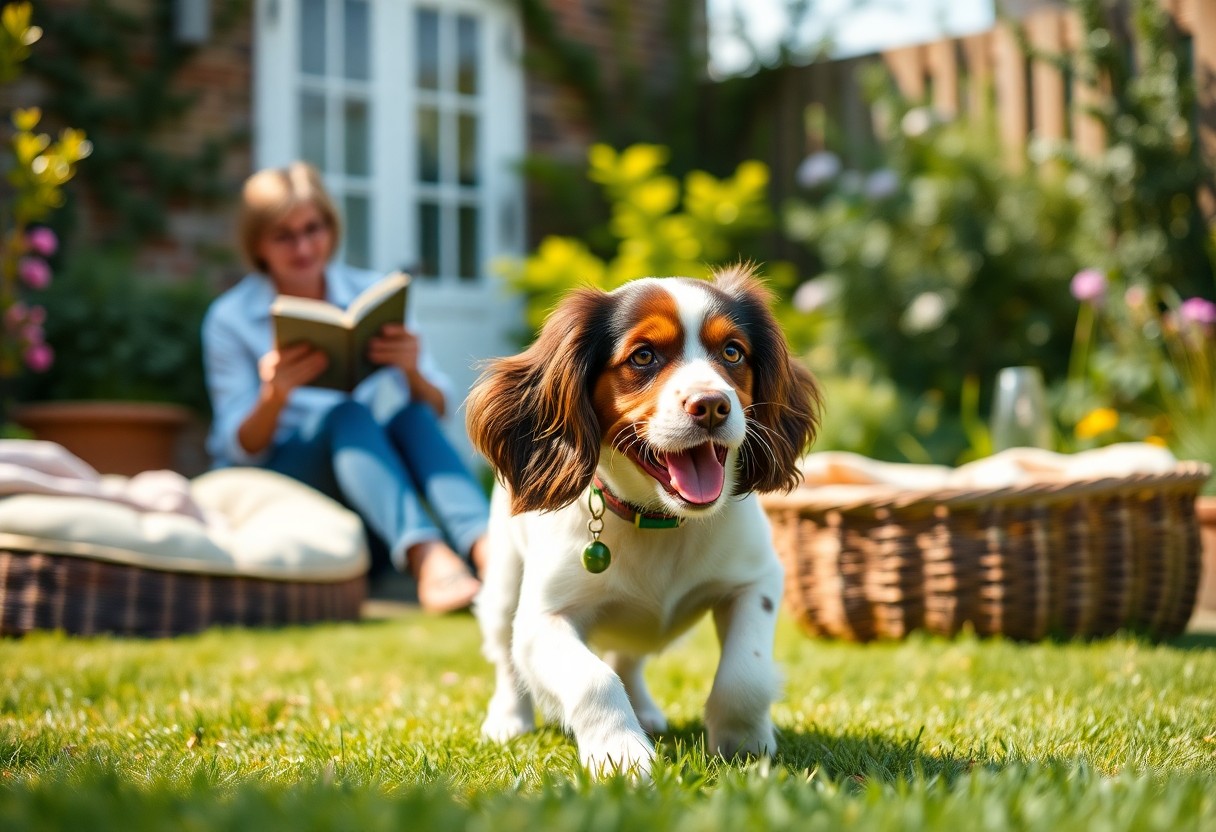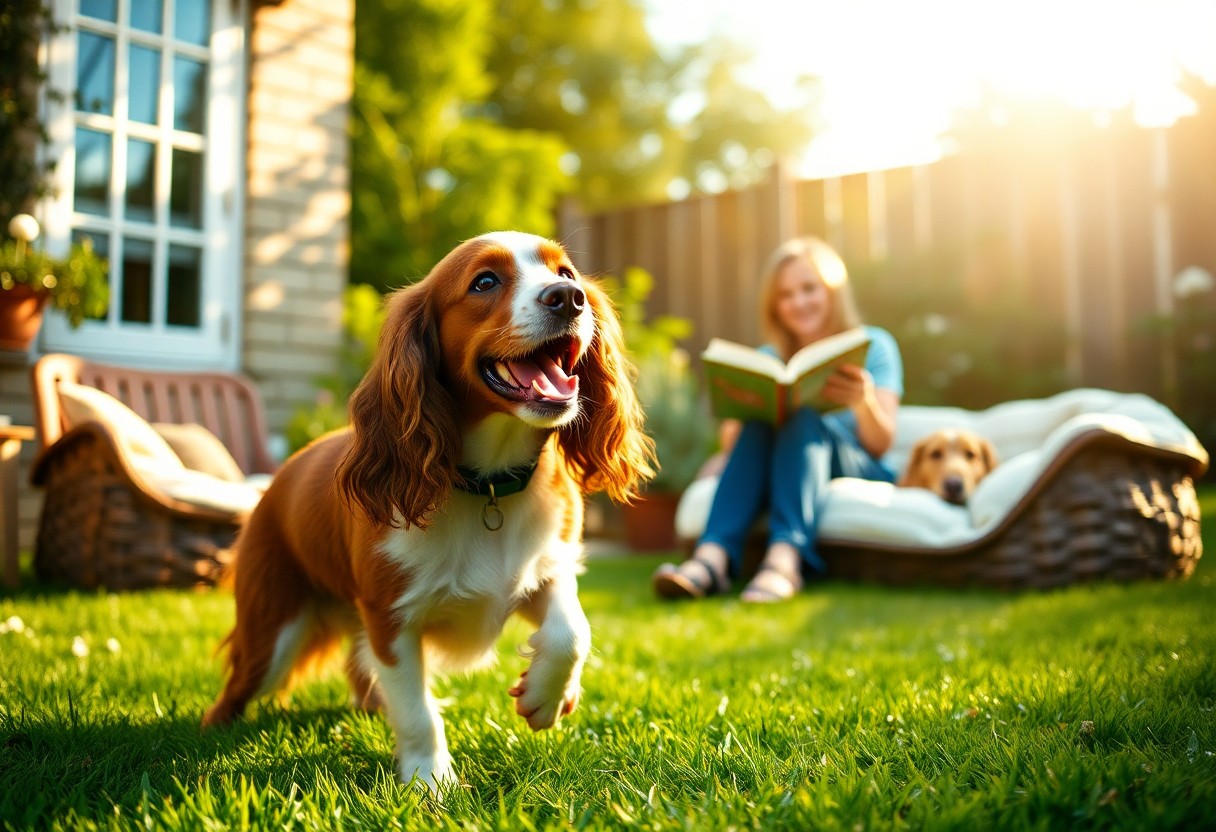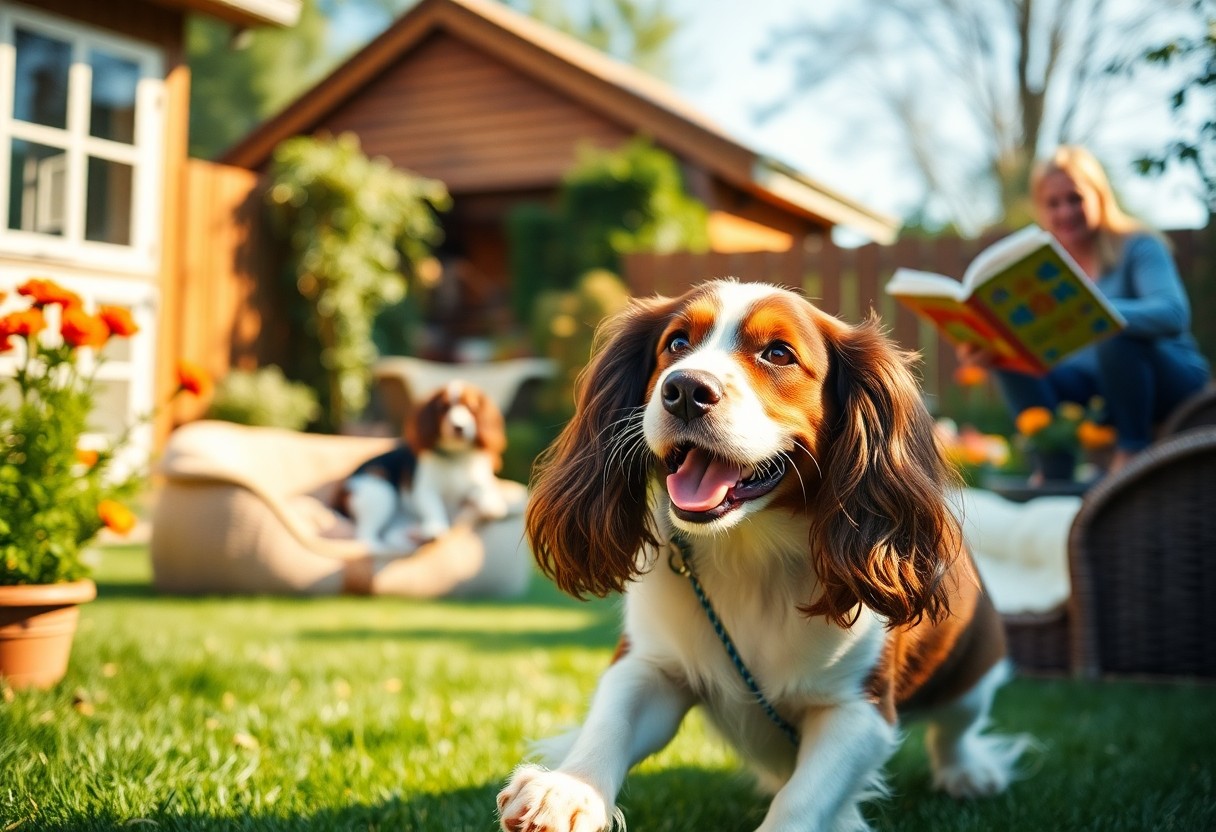Over time, separation anxiety can become a significant issue for your Spaniel, leading to stress for both you and your furry friend. By understanding your dog’s needs and implementing effective strategies, you can create a positive environment that fosters independence and emotional well-being. This guide will provide you with practical tips to ensure your Spaniel feels secure when alone, reducing their anxiety and preventing unwanted behaviors. Give your Spaniel the confidence they need, and you’ll both enjoy a happier, healthier relationship.
Key Takeaways:
- Gradually acclimate your Spaniel to being alone by starting with short periods and gradually increasing the duration.
- Provide engaging toys and puzzles to keep your Spaniel occupied while you are away.
- Create a comfortable and safe space for your Spaniel to relax in, complete with familiar items like blankets and toys.
- Establish a consistent routine for departure and arrival, helping your Spaniel predict when you will be leaving and returning.
- Consider professional training or classes to strengthen your Spaniel’s independence and socialization skills.
- Use positive reinforcement when your Spaniel demonstrates calm behavior during your absences.
- Consult with a veterinarian if separation anxiety persists, as they may recommend behavioral therapy or medication options.
Understanding Separation Anxiety
For many dog owners, understanding separation anxiety is key to ensuring their Spaniel feels safe and secure when left alone. This condition can occur when your dog becomes overly attached and fearful of being separated from you, leading to distressing behaviors when you are out of sight. By recognizing the signs early, you can take steps to prevent these issues from escalating.
What is Separation Anxiety?
With separation anxiety, your Spaniel may experience significant emotional distress when left alone. This can manifest in various behaviors, such as excessive barking, destructive chewing, or inappropriate elimination. Understanding this anxiety is vital for devising effective strategies to help your furry friend cope when you’re away.
Signs and Symptoms in Spaniels
Spaniels can display a variety of signs when suffering from separation anxiety. You might notice your dog exhibiting behaviors such as excessive barking or whining, destructive chewing on furniture or belongings, or even urinating or defecating indoors. Your Spaniel may also demonstrate signs of distress when you prepare to leave, like following you closely or becoming agitated. Additionally, some dogs may engage in compulsive behaviors, such as pacing or attempting to escape.
Anxiety can lead to severe behaviors in Spaniels, which can be distressing for both you and your dog. Specifically, look out for repetitive actions like pacing or digging, and vocalizations that intensify when you are about to leave. A sudden increase in energy or hyperactivity before you depart may also indicate anxiety. Recognizing these signs early enables you to address your Spaniel’s needs and implement effective strategies to mitigate their distress, ultimately leading to a happier and more secure companion.
Factors Contributing to Separation Anxiety
Even though some dogs are more prone to separation anxiety than others, several factors can contribute to it in your Spaniel. These include:
- Genetics
- Previous traumas
- Changes in routine
- Lack of socialization
Knowing these factors can help you take proactive measures to support your dog’s emotional well-being. For more information, check out the Tips to Reduce Separation Anxiety : r/cockerspaniel.
Breed Characteristics
One of the main reasons your Spaniel might experience separation anxiety is their inherent need for companionship. Known for their affectionate nature, Spaniels often struggle when left alone for extended periods as they thrive in social environments.
Early Life Experiences
While early life experiences play a significant role in developing your Spaniel’s temperament, negative events can heighten their anxiety levels. A separation from their mother or siblings at a young age may lead to difficulty coping with your absence later in life. Additionally, inconsistent training or exposure to stressful situations can create deeper anxiety issues. Therefore, fostering a positive, loving environment from the very start is imperative for developing a secure and well-adjusted dog.
How to Prevent Separation Anxiety
Once again, preventing separation anxiety in your Spaniel begins with understanding their needs. By recognizing the signs of anxiety and proactively addressing them, you can create a comfortable environment that fosters independence. Encourage positive associations with alone time by gradually increasing the duration and frequency of short separations, ensuring they feel safe and secure even when you’re not home.
Gradual Desensitization
One effective method to prevent separation anxiety is gradual desensitization. This technique involves gradually increasing the time you spend away from your Spaniel, allowing them to adjust to your absence without feeling overwhelmed. Start with short periods, ensuring your dog remains calm and comfortable, then slowly extend the duration to help them acclimate.
Establishing a Routine
On the other hand, establishing a routine can significantly benefit your Spaniel’s emotional well-being. Consistency in feeding, walking, and playtime helps your dog understand what to expect, reducing anxiety during your absence. By providing a structured environment, you instill a sense of security that can ease their worries.
It is important to create a clear and predictable daily schedule for your Spaniel. Routine helps them feel in control, which can mitigate feelings of anxiety when you leave. Set specific times for feeding, walks, and play, and stick to this routine, making your dog’s daily life more manageable. Also, provide mental stimulation through puzzle toys during your absence, as this can occupy their mind and decrease stress. When your Spaniel knows what to expect from their day, they may be less likely to experience separation anxiety.
Tips for Managing Alone Time
To effectively manage your Spaniel’s alone time, consider the following tips:
- Introduce short absences gradually
- Establish a consistent routine
- Leave interactive toys to keep them occupied
- Practice desensitization to your departure cues
- Use calming aids when necessary
This will help reduce feelings of anxiety and build your Spaniel’s confidence while alone.
Creating a Safe Space
Now, focus on creating a designated safe space for your Spaniel where they can feel secure during your absence. Ensure this area is comfortable with their bed, favorite toys, and familiar scents. Avoid placing them in restrictive spaces that might increase anxiety. A well-defined safe zone will help them relax and reduce feelings of separation.
Interactive Toys and Activities
Space is necessary for keeping your Spaniel engaged while you’re away. Invest in interactive toys that challenge them mentally and physically. Puzzle feeders or treat-dispensing toys can stimulate their minds and prevent boredom. Regularly rotating these toys will keep them fresh and exciting. Consider activities like hide-and-seek with treats to encourage exploration. These engaging activities minimize feelings of isolation and foster a positive association with your absence.
Tips for choosing interactive toys include selecting those designed specifically for dogs and ensuring they are safe and durable. Look for options with adjustable difficulty to cater to your Spaniel’s skill level. Avoid toys with small parts that could pose a choking hazard. Always supervise your dog during playtime to maintain safety. Providing a mix of physical and mental stimulation can help increase their confidence and reduce separation anxiety, leaving both you and your Spaniel happy when you are apart.
Enhancing Socialization Skills
Many dog owners overlook the importance of socialization in preventing Separation Anxiety in Dogs: Signs, Causes, and Prevention. By actively engaging your Spaniel with various people, pets, and situations, you can help them build confidence and adaptability. Structured playdates, puppy classes, or exposure to different environments can foster better social skills, ensuring your dog feels secure and less anxious when left alone.
Exposure to Different Environments
Enhancing your Spaniel’s exposure to different environments helps them gain vital experience that combats anxiety. Take your dog to parks, bustling streets, or even friends’ homes to introduce new sights, sounds, and scents. This variety not only enriches their daily life but also allows them to learn how to cope with unfamiliar situations, reducing their overall anxiety level.
Positive Reinforcement Techniques
An effective way to improve your Spaniel’s socialization skills is through positive reinforcement techniques. Rewarding your dog with treats, praise, or playtime during and after successful interactions helps create positive associations with new experiences. This approach teaches your Spaniel that being around new people and environments is a rewarding experience, effectively decreasing their likelihood of developing separation anxiety.
Another method to reinforce good behavior is to gradually expose your Spaniel to different scenarios while employing positive reinforcement. Start with less intimidating situations and reward your dog for calm behavior. Over time, expose them to more challenging environments, ensuring that you offer consistent praise and treats. This establishes a strong connection between positive experiences and socialization, ultimately leading to a more confident, well-adjusted Spaniel who can handle being alone without fear.
Professional Help and Resources
All owners of Spaniels should consider seeking professional help for separation anxiety. Trainers who specialize in canine behavior can provide valuable insights tailored to your dog’s needs. You may find it helpful to explore discussions on forums like How do you help cocker spaniel separation anxiety?, where other owners share their experiences and solutions.
When to Seek a Trainer
Assuming you notice signs of severe anxiety in your Spaniel, such as destructive behavior or incessant barking, it may be time to seek a professional trainer. This step can prevent escalation and ensure your dog receives the support they need to feel secure in your absence.
Helpful Tools and Aids
One effective way to aid your Spaniel’s adjustment is through the use of various tools available on the market. Products like anxiety wraps or calming pheromone diffusers can create a sense of security and comfort.
Understanding your Spaniel’s needs is vital to reducing separation anxiety effectively. Anxiety wraps provide gentle pressure, creating a feeling of calm, while calming pheromone diffusers release soothing scents that can ease your dog’s tension. Additionally, interactive toys can keep your Spaniel engaged during your absence, making the time apart easier. By utilizing these tools, you enhance your dog’s emotional well-being and can create a more relaxed environment for both of you.
Conclusion
The key to preventing separation anxiety in your Spaniel lies in early socialization and consistent training. You should gradually acclimate your pup to being alone by starting with short departures and slowly increasing the time apart. Engaging your dog with stimulating toys and puzzles can also help keep their mind occupied. Establishing a comfortable, dedicated space for your spaniel and reassuring them through positive reinforcement during your departures and returns can instill confidence. By implementing these strategies, you create a secure environment that fosters your dog’s independence.
FAQ
Q: What are the common signs of separation anxiety in Spaniels?
A: Common signs include excessive barking, destructive behavior, attempting to escape, bathroom accidents indoors, and signs of distress, such as pacing or drooling when their owner prepares to leave.
Q: How can I help my Spaniel feel more comfortable when I’m not home?
A: Gradually desensitize your Spaniel to your departures by practicing short absences that increase in duration. Provide a comfortable, safe space with their favorite toys and blankets. You could also use calming aids like pheromone diffusers or anxiety wraps to ease their stress.
Q: Should I crate train my Spaniel to prevent separation anxiety?
A: Crate training can be beneficial, provided it is done gradually and positively. The crate should be a safe haven for your Spaniel, not a punishment. Start by allowing your Spaniel to explore the crate and gradually introduce short periods of confinement, rewarding them for calm behavior.
Q: Is it a good idea to leave my Spaniel with another pet to manage their anxiety?
A: If your Spaniel gets along well with other pets, having a companion can be helpful. However, it’s important to introduce them gradually and ensure both pets feel comfortable with each other. Individual temperament varies, so evaluate your Spaniel’s reactions.
Q: How can I incorporate positive reinforcement to reduce separation anxiety in my Spaniel?
A: Use treats, praise, and affection to reward your Spaniel for calm behavior during your departures and arrivals. For example, when you leave, avoid overly emotional goodbyes and focus on rewarding relaxed behavior instead.
Q: What activities can help tire out my Spaniel before I leave them alone?
A: Engage your Spaniel in physical activities such as long walks, play sessions with their favorite toys, or interactive games like fetch. Mental stimulation can also be achieved through puzzle toys that challenge them to solve problems for treats.
Q: When should I seek professional help for my Spaniel’s separation anxiety?
A: If your Spaniel shows severe symptoms of anxiety that you are unable to manage through basic training or environmental adjustments, consider consulting a veterinarian or a certified dog trainer who specializes in behavior issues. They can provide tailored advice or suggest behavioral modification strategies and possibly medication if necessary.


